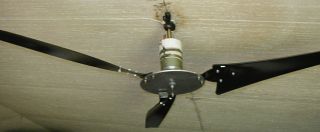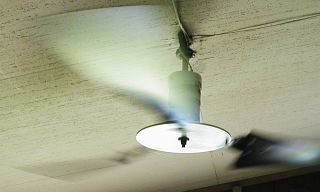Here in the tropics, staying comfortably cool is a year round effort. With temperatures that seldom dip below 75F(24C) and humidity levels usually greater than 75%, fans play an important role in maintaining our cool. Even with expensive-to-power air conditioning, fans can help mitigate the cost. I'm sure these comments are somewhat lost on those of you in the northern hemisphere who are just coming out of the throes of winter.
A while back, I took a look at the power consumption of a single, garden-variety, flat bladed, 52" ceiling fan running on AC, at medium speed (about 120 RPM) and found it to be 45W at 120Vac, 60Hz. For my typical daily running time, it cost about US$100 annually to run it (28 cents/kWh). Another down side is that all of that power consumption is dissipated in the room as heat. Talk about counter-productive!
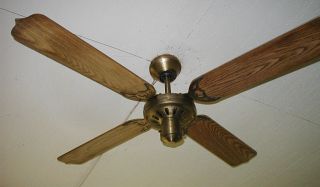
Considering that I run three of these at various times of the day in different rooms and that the cost of grid energy steadily soars upward, I thought it time to address the problem. The first test was to switch the most often used fan to the 12Vdc RE system via a small 200W inverter that also powers a few CFLs in the area. This worked fine and reduced the utility bill but at a burden of about 50Ah/day to the RE system. This is a pretty high percentage of my RE production and made me cut back computer time to compensate. Not too satisfactory.
The issue with ceiling fans is twofold - inefficiency of the rotor and inefficiency of that type of AC motor. We really need very little power to generate the gentle air velocity needed.
The Rotor
A report from Florida State confirmed what I thought all along about flat blades for fans. They really aren't very good at moving air. Similarly, they aren't very good for wind turbines either.
http://www.fsec.ucf.edu/en/publications/html/FSEC-CR-1059-99/index.htm
This report resulted in a blade design that strongly resembles what we might consider to be a good design for wind turbines except with blade angles and twist direction reversed, of course. It uses a "real" airfoil, taper and twist. They call this design the "Gossamer Wind".
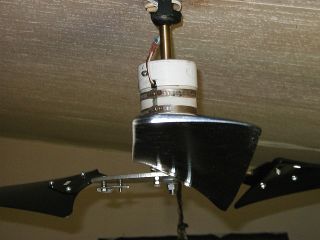
I searched for commercial fans using this or similar blades and found a few. One that stood out was a DC version called the Vari Cyclone. It runs on 12-24V and only needs 4W at 12V. The only problem is a price tag of about $200 and not very wide availability.
My local ACE hardware store has a demo area set up with various fan models and I noticed an all-black model with similar blades. Standing under this "plain-Jane" model, I was rewarded with a good blast of air even though it was running at a quite modest speed. Compared to other fancier flat blade models running much faster, it put out a LOT more air. It is an Emerson Model HF 1160 and called "60" Industrial Heat Fan" (Heat??). This very unscientific test convinced me that it had merit, so I took one home at a sale price of $99.
Even though I was only interested in the rotor, it came with a powerful 156W, single speed AC motor that is intended to use a speed control. Maybe I'll find a use for it someday. Nice motor, albeit inefficient.
The blades (762495) and flanges (762497) are available from Emerson Parts (1-800-654-3545) for $55 and $28 per set of three, respectively (thanks Nanotech).
The Motor
A few years back, I bought a batch of Ametek 30V tape-drive motors on eBay to look at their wind turbine potential. Those tests were pretty disappointing so they were stuck on the back shelf (I am using a 50V however). As a low speed DC motor however, they perform quite well. I ran tests at 12 volts and lower and found the speed range quite suitable to a ceiling fan (60-140 RPM, loaded) and their power consumption was quite low.
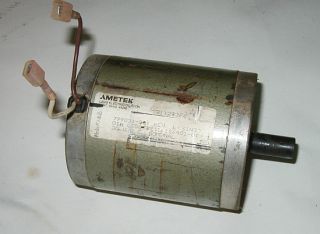
Yes, the Ametek is a brushed motor which will eventually require brush replacement, but at 100 RPM and less than one amp of current, I expect them to last for a long time.
The Prototype
A 12" disk of 0.25" aluminum was cut to serve as a rotor hub. The original motor/hub is about 8" diameter, but I wanted to enlarge the swept area a bit. With the 12" hub, the rotor diameter is about 65".
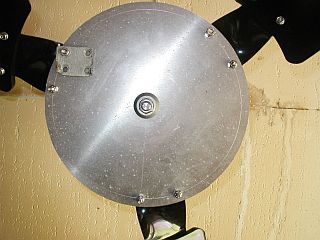
By the way, I cut aluminum plate with a common wood router with a ¼" carbide straight bit and a homebrew circle jig. Works fine, although a bit slow going. It leaves a reasonable edge finish.
A 5/8" to ½" arbor connects the Ametek to the aluminum hub and the blade flanges are bolted to the hub periphery using stainless Nylock (nylon insert) nuts.
To connect the motor to the support down-tube, a piece of 4" PVC pipe with a glued end cap fit snuggly over the motor and is held in place with two stainless hose clamps. A slot is cut in the PVC to clear the wire exit point and a hole is cut in the center of the end cap to accept the down-tube. A piece of ¼" all-thread with Nylocks passes horizontally through the PVC end cap and holes in the down-tube. Two more Nylocks hold the tube centered on the motor.
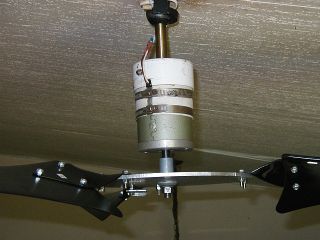
Testing
The assembled fan was mounted on a test stand with the rotor vertical. This allowed balancing the assembly and access to the motor while avoiding spinning blades. The odd bit of steel on one of the blade hub bolts took care of the balance issue.
A 10 Ohm rheostat was connected in series with the motor and a 12Vdc source along with metering for voltage, current and RPM.
Motor voltage, current and calculated power were measured at three speeds.
At 80 RPM - 6.1V, 0.5A and 3.1W.
At 100 RPM - 8.0V, 0.8A and 6.4W.
At 135 RPM - 12.6V, 1.5A and 18.9W.
At the highest speed it was blowing an impressive gale, which I don't think I would ever use. I anticipate the mid-speed being used the majority of the time as it still moves a lot of air. The blades are actually rated to run up to 200 RPM, which I can't quite imagine.
The Controller
Since a series resistor would dissipate about 3W at 100 RPM, I decided to build a very simple PWM controller to reduce this loss. At 90% efficiency it would dissipate well under a watt. This was roughly confirmed by a small, measured 6^C temperature rise of the FET's small heat sink. With 10 total parts, its level of complexity was well in keeping with this simple task and provides variable speed control.
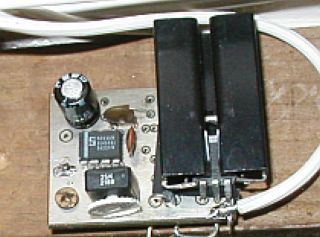
Results
This has been quite a rewarding project except that it has delayed some of my other pet projects. I often seem to get sidetracked this way.
I should save about $100 annually on grid power at the expense of about 8-9Ah of 12V RE energy per day and I put the old Ametek to good use. It moves roughly twice as much air at a lower speed than my old fan and, as a bonus, is absolutely silent. It won't win any beauty contests but I don't look up all that often.
All I have to do now is build two more.
